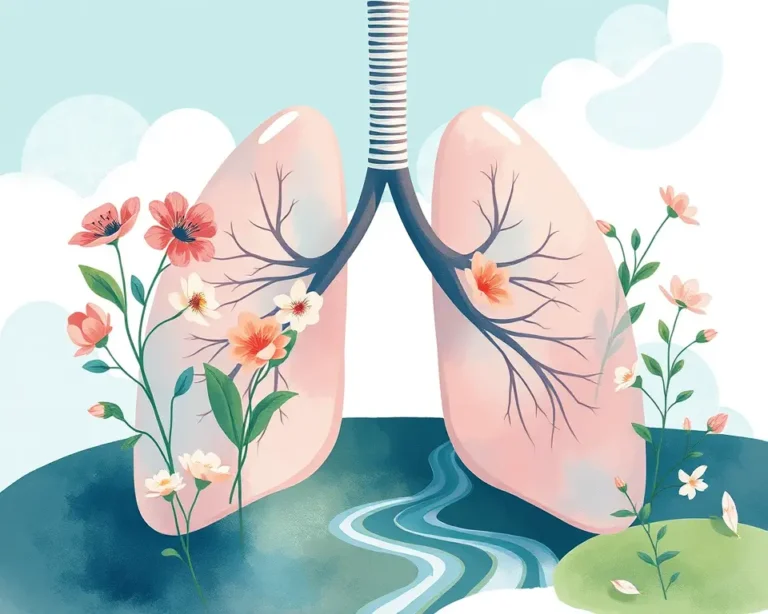Are you struggling with breathing difficulties? Do you find yourself short of breath after minimal exertion? In today’s world, where pollution and sedentary lifestyles are increasingly common, maintaining optimal lung health is more important than ever. While medical treatments are essential, incorporating natural and complementary therapies can significantly improve your respiratory well-being. Yoga, with its emphasis on controlled breathing, specific postures (asanas), and relaxation techniques, offers a holistic approach to enhancing lung capacity and easing breathing troubles. This article presents a simple, 5-minute yoga routine that can be easily integrated into your daily life to promote healthier, stronger lungs.
Why Yoga for Lung Health?
Yoga benefits the lungs by enhancing respiratory capacity, improving airflow, and promoting overall lung efficiency. Controlled breathing exercises and specific asanas in yoga can significantly improve lung health. Deep, mindful breathing helps increase lung capacity, promoting better oxygen exchange. Techniques like diaphragmatic breathing and alternate nostril breathing improve respiratory function by engaging the entire lung area.
Here’s how yoga helps:
- Increased Lung Capacity: Yoga poses and breathing exercises improve the efficiency and capacity of the lungs. Techniques like deep breathing and diaphragmatic breathing strengthen respiratory muscles and promote complete oxygen exchange.
- Strengthening Respiratory Muscles: Certain yoga poses engage and strengthen the muscles involved in breathing, including the diaphragm and intercostal muscles, enhancing lung capacity and efficiency.
- Improved Oxygen Circulation: Yoga practices that emphasize controlled breathing and mindful movement improve oxygen circulation throughout the body, supporting overall respiratory health and boosting energy levels.
- Reduced Inflammation: Yoga’s stress-relieving benefits lower cortisol and other stress hormones, potentially reducing systemic inflammation.
- Stress Reduction: Yoga stimulates the parasympathetic nervous system, triggering the body’s relaxation response, alleviating symptoms associated with respiratory conditions like wheezing, shortness of breath, and chest tightness.
- Improved Posture: Yoga helps correct posture imbalances by promoting alignment and awareness of body positioning, allowing for better lung expansion and airflow.
- Boosted Immunity: Regular yoga practice strengthens the immune system, reducing the risk of respiratory infections and illnesses, and promoting faster recovery from respiratory-related ailments.
Understanding the Breath
The breath is life. It is a fundamental and vital process that sustains all bodily functions. In yoga, breath, known as prana, is considered the life force. Proper breathing techniques ensure that the body receives an adequate supply of oxygen, which is essential for energy production, cellular repair, and overall health.
Types of Breathing
- Diaphragmatic Breathing (Belly Breathing): This technique involves deep breathing from the diaphragm, allowing for full oxygen exchange. It helps to strengthen the diaphragm, the primary muscle for breathing, and improves oxygen distribution to all parts of the lungs.
- Pursed-Lip Breathing: This technique slows down your breathing, reducing the work needed by keeping your airways open longer. It makes it easier for the lungs to function and improves oxygen and carbon dioxide exchange.
- Alternate Nostril Breathing (Anulom Vilom): This balances oxygen flow between both lungs, clears nasal passages, and improves overall lung function.
- Bhastrika Pranayama (Bellows Breath): This increases lung capacity and boosts oxygen levels in the body, beneficial for those with asthma or bronchitis.
- Kapalabhati (Skull-Shining Breath): This breathing technique detoxifies the lungs by expelling stale air and enhances lung elasticity.
A 5-Minute Yoga Routine for Lung Health
This routine incorporates specific yoga poses and breathing exercises to help improve lung capacity, strengthen respiratory muscles, and promote relaxation. Remember to consult with your doctor before starting any new exercise routine, especially if you have underlying health conditions.
1. Diaphragmatic Breathing (1 minute)
- How to:
- Lie on your back with your knees bent and feet flat on the floor. You can also sit comfortably in a chair.
- Place one hand on your chest and the other on your belly, just below your ribs.
- Inhale slowly and deeply through your nose, allowing your belly to rise as you fill your lungs with air. The hand on your belly should move more than the hand on your chest.
- Exhale slowly through your mouth, allowing your belly to fall.
- Continue for 1 minute, focusing on the rise and fall of your belly with each breath.
- Benefits: Strengthens the diaphragm, improves oxygen distribution, and promotes relaxation.
2. Pursed-Lip Breathing (1 minute)
- How to:
- Sit comfortably in a chair or lie on your back.
- Relax your neck and shoulder muscles.
- Inhale slowly through your nose for about two seconds, keeping your mouth closed.
- Purse your lips as if you’re about to blow out a candle.
- Exhale slowly and gently through your pursed lips for about four seconds, making a quiet hissing sound.
- Repeat for 1 minute, focusing on the slow, controlled exhale.
- Benefits: Controls shortness of breath and helps maintain open airways for longer, especially beneficial for individuals with COPD.
3. Cobra Pose (Bhujangasana) (1 minute)
- How to:
- Lie face down on the floor with your legs extended and your hands under your shoulders, palms flat.
- Inhale as you lift your chest off the floor, keeping your lower body grounded.
- Engage your back muscles and open your chest, drawing your shoulders back and down.
- Hold the pose for 15-30 seconds, breathing deeply.
- Exhale as you slowly lower your chest back to the floor.
- Repeat 2-3 times.
- Benefits: Expands the lungs, strengthens the upper back, and improves posture.
4. Bridge Pose (Setu Bandhasana) (1 minute)
- How to:
- Lie on your back with your knees bent and feet flat on the floor, hip-width apart.
- Keep your arms at your sides, palms facing down.
- Inhale as you press through your feet and lift your hips off the floor, creating a straight line from your shoulders to your knees.
- Engage your glutes and open your chest, drawing your shoulders back and down.
- Hold the pose for 30-60 seconds, breathing deeply.
- Exhale as you slowly lower your hips back to the floor.
- Repeat 2-3 times.
- Benefits: Opens the chest cavity and promotes deeper breathing, strengthens the respiratory muscles.
5. Alternate Nostril Breathing (Nadi Shodhana) (1 minute)
- How to:
- Sit in a comfortable position with your spine straight.
- Close your right nostril with your right thumb and inhale slowly and deeply through your left nostril.
- Close your left nostril with your right ring finger and release your right thumb, exhaling slowly through your right nostril.
- Inhale through your right nostril, then close it with your right thumb and release your ring finger, exhaling through your left nostril.
- Continue alternating nostrils with each breath for 1 minute.
- Benefits: Balances oxygen flow between both lungs, clears nasal passages, and calms the mind.
Additional Yoga Poses for Lung Health
Beyond the 5-minute routine, several other yoga asanas can further enhance lung health:
- Fish Pose (Matsyasana): This pose opens the throat and chest areas, increasing lung capacity.
- Camel Pose (Ustrasana): This pose enhances lung flexibility and encourages deep inhalation.
- Bow Pose (Dhanurasana): This pose improves chest expansion and stretches the lungs, alleviating respiratory discomfort.
- Mountain Pose (Tadasana): This pose encourages proper spinal alignment, allowing for better lung expansion and airflow.
- Cat-Cow Stretch (Marjaryasana to Bitilasana): This pose promotes respiratory flexibility and coordinates movement with breath.
- Low Lunge (Anjaneyasana): This pose opens the chest and encourages deep breathing, stretching the hip flexors.
- Warrior Pose (Virabhadrasana): This pose encourages proper spinal alignment, allowing for better lung expansion and airflow.
Lifestyle Modifications
Incorporating yoga into a comprehensive treatment plan for respiratory conditions can support other lifestyle modifications, such as:
- Smoking cessation
- Maintaining a healthy weight
- Avoiding environmental triggers that exacerbate respiratory symptoms
Precautions and Considerations
While yoga offers numerous benefits for lung health, it’s essential to practice safely and mindfully:
- Consult Your Doctor: Before starting any new exercise routine, especially if you have respiratory conditions like asthma or COPD, consult your doctor.
- Work with a Certified Yoga Instructor: A certified yoga instructor with experience working with individuals with respiratory issues can provide guidance and support.
- Listen to Your Body: Pay attention to your body and adjust poses as necessary. Avoid poses that cause constriction of the airways or make it difficult to breathe deeply.
- Avoid Rapid Breathing Techniques: Poses that include rapid breathing techniques or holding of the breath can facilitate an asthma flare and should be avoided.
Conclusion
Yoga offers a holistic approach to improving lung health and easing breathing troubles. By incorporating the 5-minute routine and other beneficial poses into your daily life, you can enhance your respiratory function, reduce stress, and improve your overall well-being. Remember to practice mindfully and consult with healthcare professionals to ensure a safe and effective approach. Embrace the power of yoga and breathe your way to a healthier, happier you.







